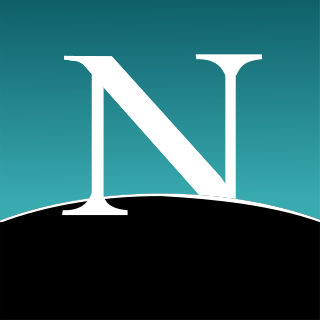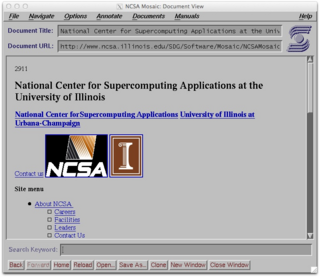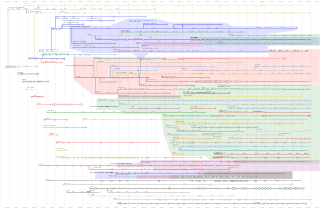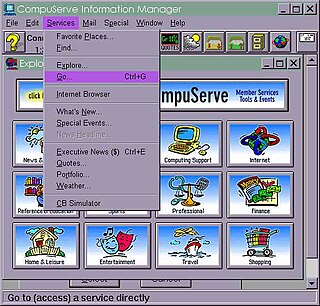
Netscape Navigator is a discontinued proprietary web browser, and the original browser of the Netscape line, from versions 1 to 4.08, and 9.x. It was the flagship product of the Netscape Communications Corp and was the dominant web browser in terms of usage share in the 1990s, but by around 2003 its user base had all but disappeared. This was partly because the Netscape Corporation did not sustain Netscape Navigator's technical innovation in the late 1990s.
Netscape Communications Corporation was an American independent computer services company with headquarters in Mountain View, California, and then Dulles, Virginia. Its Netscape web browser was once dominant but lost to Internet Explorer and other competitors in the so-called first browser war, with its market share falling from more than 90 percent in the mid-1990s to less than one percent in 2006. An early Netscape employee, Brendan Eich, created the JavaScript programming language, the most widely used language for client-side scripting of web pages. A founding engineer of Netscape, Lou Montulli, created HTTP cookies. The company also developed SSL which was used for securing online communications before its successor TLS took over.
Shareware is a type of proprietary software that is initially shared by the owner for trial use at little or no cost. Often the software has limited functionality or incomplete documentation until the user sends payment to the software developer. Shareware is often offered as a download from a website. Shareware differs from freeware, which is fully-featured software distributed at no cost to the user but without source code being made available; and free and open-source software, in which the source code is freely available for anyone to inspect and alter.

NeXTSTEP is a discontinued object-oriented, multitasking operating system based on the Mach kernel and the UNIX-derived BSD. It was developed by NeXT Computer, founded by Steve Jobs, in the late 1980s and early 1990s and was initially used for its range of proprietary workstation computers such as the NeXTcube. It was later ported to several other computer architectures.

NCSA Mosaic was among the first widely available web browsers, instrumental in popularizing the World Wide Web and the general Internet by integrating multimedia such as text and graphics. Mosaic was the first browser to display images inline with text.

Cello is an early, discontinued graphical web browser for Windows 3.1; it was developed by Thomas R. Bruce of the Legal Information Institute at Cornell Law School. It was released as shareware in 1993. While other browsers ran on various Unix machines, Cello was the first web browser for Microsoft Windows, using the winsock system to access the Internet. In addition to the basic Windows, Cello worked on Windows NT 3.5 and with small modifications on OS/2.

CompuServe was an American online service, the first major commercial one in the world. It opened in 1969 as a timesharing and remote access service marketed to corporations. After a successful 1979 venture selling otherwise under-utilized after-hours time to Radio Shack customers, the system was opened to the public, roughly the same time as The Source.
An online service provider (OSP) can, for example, be an Internet service provider, an email provider, a news provider (press), an entertainment provider, a search engine, an e-commerce site, an online banking site, a health site, an official government site, social media, a wiki, or a Usenet newsgroup.

A browser war is a competition for dominance in the usage share of web browsers. The "first browser war" (1995–2001) consisted of Internet Explorer and Netscape Navigator, and the "second browser war" (2004-2017) between Internet Explorer, Firefox, and Google Chrome.

eWorld was an online service operated by Apple Inc. between June 1994 and March 1996. The services included email, news, software installs and a bulletin board system. Users of eWorld were often referred to as "ePeople."
Spyglass, Inc. was an Internet software company. It was founded in 1990, in Champaign, Illinois, as an offshoot of the University of Illinois at Urbana–Champaign, and later moved to Naperville, Illinois. Spyglass was created to commercialize and support technologies from the National Center for Supercomputing Applications (NCSA). It focused on data visualization tools, such as graphing packages and 3D rendering engines.

The Line Mode Browser is the second web browser ever created. The browser was the first demonstrated to be portable to several different operating systems. Operated from a simple command-line interface, it could be widely used on many computers and computer terminals throughout the Internet. The browser was developed starting in 1990, and then supported by the World Wide Web Consortium (W3C) as an example and test application for the libwww library.

IBM WebExplorer was an early web browser designed at IBM facilities in the Research Triangle Park for OS/2.

SlipKnot was one of the earliest World Wide Web browsers, available to Microsoft Windows users between November 1994 and January 1998. It was created by Peter Brooks of MicroMind, Inc. to provide a fully graphical view of the web for users without a SLIP or other TCP/IP connection to the net, hence the name – SLIP...not. SlipKnot provided a graphical web experience through what would otherwise be a text-only Unix shell account. SlipKnot version 1.0 was released on November 22, 1994, approximately 3 weeks before Netscape's Netscape Navigator version 1.0 came out. It was designed to serve a significant fraction of PC/Windows-based Internet users who could not use Mosaic or Netscape at that time.

CompuServe Information Manager (CIM) was CompuServe Information Service's client software, used with the company's Host Micro Interface (HMI). The program provided a GUI front end to the text-based CompuServe service that was at the time accessed using a standard terminal program with alphanumerical shortcuts.

The World Wide Web is a global information medium that users can access via computers connected to the Internet. The term is often mistakenly used as a synonym for the Internet, but the Web is a service that operates over the Internet, just as email and Usenet do. The history of the Internet and the history of hypertext date back significantly further than that of the World Wide Web.
IBox was one of the first commercially available Internet connection software packages available for sale to the public. O'Reilly & Associates created and produced the package, in collaboration with Spry, Inc. Spry, Inc. also started up a commercial Internet service provider (ISP) called InterServ.

MacWWW, also known as Samba, is an early minimalist web browser from 1992 meant to run on Macintosh computers. It was the first web browser for the classic Mac OS platform, and the first for any non-Unix operating system. MacWWW tries to emulate the design of WorldWideWeb. Unlike modern browsers it opens each link in a new window only after a double-click. It was a commercial product from CERN and cost 50 European Currency Units
A web browser is a software application for retrieving, presenting and traversing information resources on the World Wide Web. It further provides for the capture or input of information which may be returned to the presenting system, then stored or processed as necessary. The method of accessing a particular page or content is achieved by entering its address, known as a Uniform Resource Identifier or URI. This may be a web page, image, video, or other piece of content. Hyperlinks present in resources enable users easily to navigate their browsers to related resources. A web browser can also be defined as an application software or program designed to enable users to access, retrieve and view documents and other resources on the Internet.

tkWWW is an early, now discontinued web browser and WYSIWYG HTML editor written by Joseph Wang at MIT as part of Project Athena and the Globewide Network Academy project. The browser was based on the Tcl language and the Tk (toolkit) extension but did not achieve broad user-acceptance or market share, although it was included in many Linux distributions by default. Joseph Wang wanted tkWWW to become a replacement for r r n and to become a "swiss army knife" of networked computing.













